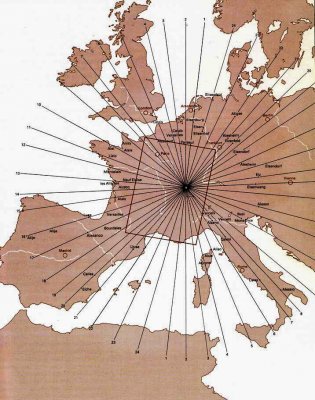[Minor edits: correcting open/closed quotes for clarity. No changes to the wording.]
I remember falling victim to the ley hunting bug as a teenager and again in my 20s. I was excited to "discover" that Southwell Minster (near to where I live) is "on a ley line".
However...
The original idea of the ley line was no more than "the old straight track". Alfred Watkins' initial concept was a network of rectilinear transport routes across the countryside, joining landmarks.
Watkins came up with the name "ley", allegedly because he noticed an association with place names ending in "ley". As that is a common ending, meaning "lea" ("meadow") he may as well have called them "ton lines" or "ham lines" or "thorpe lines".
It was soon realised that the straight tracks that Watkins had postulated would not be practical routes because they sometimes did things like crossing marshes and wide rivers and going up steep cliffs. Real walking routes tend meander as they follow ridges, valleys and contours and use shallow crossings of rivers.
Rather than dropping the idea as obviously silly, people scratched around looking for an alternative "explanation" for this completely illusory phenomenon. They postulated some ancient lost wisdom, and some ill-defined primordial force. Later this became associated in some people's minds with disparate ideas such as acupuncture: menhirs as acupuncture needles to cure the Earth, blah blah.
Aside: I remember going to Arbor Low in Derbyshire and seeing two things at the same time: the farmer's daughter on a quad bike riding around the inside of the ancient earth bank as if it were a wall of death, and a couple of harmless eccentrics dangling pendulums (pendula?) over the stones. I swear I heard one of them shout to his companion words to the effect, "I've found a nexus of primeval force."
Back onto my own straight track: I read a number of books on leys at the time (the word "line" had largely been dropped by then) and there were various pseudo statistical ways of calculating the lines. A church was worth 3 points, a standing stone worth 4, a cross roads 2, and so on. (I made up these numerical values for the sake of illustration.) A quick review of the list showed that things like "a straight section of road" or "a distinctive hill top" were also on the list.
Given enough random and unrelated items like that, it will always be possible to find alignments that add up to some arbitrary threshold number. However, a little thought shows that these are not completely random and unrelated items. It is common for a road to head in a straight line towards a major church. Cross roads are always on roads, some of which have straight sections. A standing stone or church may be on a distinctive hilltop. A church may be built on an earlier religious site. And so on.
On the other hand, items that appear at first glance to be related, such as "earthworks" may be separated in age by 3,000 years and be from different cultures and belief systems. Of four "ancient earthworks", one may be defensive, one funerary, one agricultural, and one ritual.
Any two points will always be in a straight line relative to each other. The chance that a third random point is within a degree either side of that line is 1/180. That's not rare. if I had a 1/180chance of being knocked off my motorbike every ride, I would not ride it.
The chance of a fourth point being within 1 degree of the same line is also 1/180, so the chance of points 3 and 4 both being within a degree of the line between points 1 and 2 is 1/(180*180) which is 1/32,400 which is a small chance.
However, if you allow yourself the freedom to look for any and all possible alignments, then the more random points you have, the more alignments you will find, because every pair of points is a new line that a third or fourth point may also be on. It's like the thing with birthdays: the chance of a single random stranger having the same birthday as you is around 1/365, but if you have 50 people in the room, it is extremely likely that two of them will have the same birthday as each other.
The clever thing is, don't count all the things that are not aligned. "I looked at 20 sites and found 6 alignments of 3," is more impressive than, "Out of 190 pairs of points, I found 6 cases where a third point was in line."
Of course, this does not preclude the possibility that some ancient sites were deliberately aligned with each other. Items of a similar age, or built in obvious succession for related purposes may well be aligned. That is a natural human urge to be orderly. Whether or not the "wise ancients" believed in any force flowing along those lines, there is no evidence that such a force exists.
Ley lines: fun, interesting, but a barmy idea.



 ] was a very rare occurrence in real or randomised data. The program never found one which didn't have a fat earthwork (or two) in it somewhere.
] was a very rare occurrence in real or randomised data. The program never found one which didn't have a fat earthwork (or two) in it somewhere.